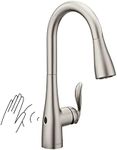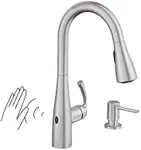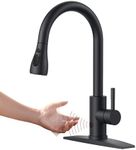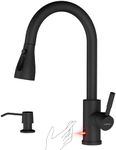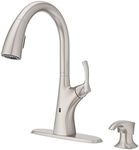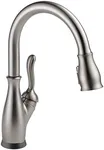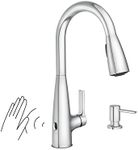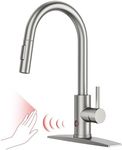Buying Guide for the Best Touchless Kitchen Faucets
Choosing a touchless kitchen faucet can make your kitchen more convenient, hygienic, and modern. These faucets use sensors to detect your hand movement, allowing you to turn the water on and off without touching the handle. When picking the right one, it's important to consider how you'll use it daily, the size and style of your sink, and the features that will make your kitchen tasks easier and cleaner.Sensor Type and SensitivityThe sensor is what makes a touchless faucet work, detecting motion to turn the water on or off. Some faucets use infrared sensors, while others use capacitive touch or ultrasonic sensors. Sensitivity refers to how easily the faucet responds to your hand movements. High sensitivity means the faucet will react quickly, but if it's too sensitive, it might turn on accidentally. If you have a busy kitchen or kids, you might want a faucet with adjustable sensitivity or a sensor that only activates when your hand is very close. For smaller households, a standard sensor may be enough.
Power SourceTouchless faucets need power to operate their sensors, usually from batteries or an AC adapter. Battery-powered models are easier to install and don't require an outlet, but you'll need to change batteries every few months to a year, depending on usage. AC-powered faucets plug into a wall outlet and don't need battery changes, but installation can be trickier if you don't have an outlet under your sink. If you want a simple setup, go for battery power; if you prefer less maintenance and have an outlet available, AC power is a good choice.
Spout Height and ReachSpout height is how tall the faucet is from the base to the highest point, and reach is how far the spout extends over the sink. A higher spout gives you more space to fill large pots or wash big items, while a longer reach ensures the water flows into the center of your sink. If you have a deep or double sink, a higher and longer spout can be helpful. For smaller sinks, a lower spout may fit better and prevent splashing.
Manual OverrideA manual override lets you use the faucet like a regular one if the sensor stops working or if you want more control. This is important for times when the power is out or the batteries die. If you want peace of mind and flexibility, look for a faucet with a manual handle that works even when the sensor is off.
Spray FunctionsMany touchless faucets offer different spray modes, such as stream, spray, or pause. These modes help with different kitchen tasks, like rinsing vegetables or filling pots. If you do a lot of cooking or cleaning, a faucet with multiple spray options can make your work easier. If you mostly use your faucet for simple tasks, a basic stream function may be enough.
Finish and MaterialThe finish and material affect how the faucet looks and how easy it is to keep clean. Common finishes include chrome, stainless steel, matte black, and brushed nickel. Some finishes resist fingerprints and water spots better than others. If you want a faucet that stays looking clean with less effort, choose a finish that resists smudges and matches your kitchen style.
Installation CompatibilityNot all faucets fit every sink. Check how many holes your sink has and whether the faucet comes with the right mounting hardware. Some faucets need a single hole, while others can cover multiple holes with a deck plate. Make sure the faucet you choose will fit your sink setup to avoid extra work or returns.


